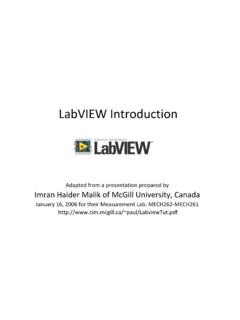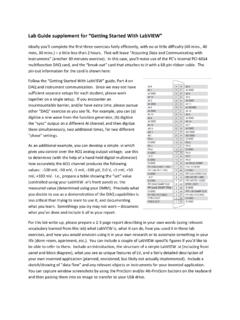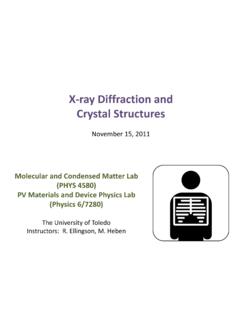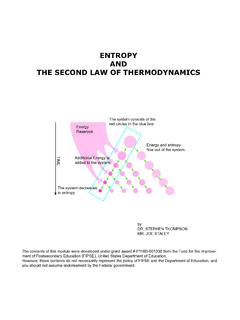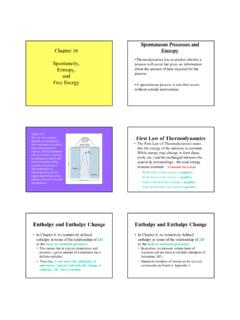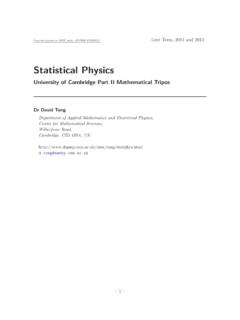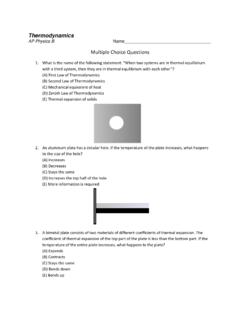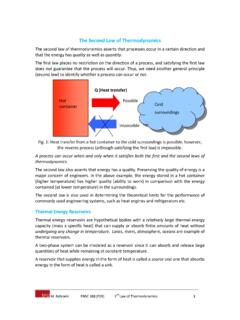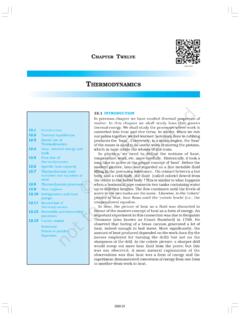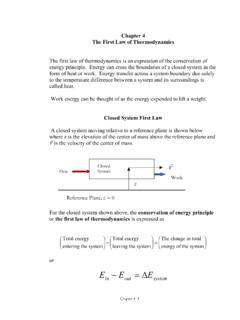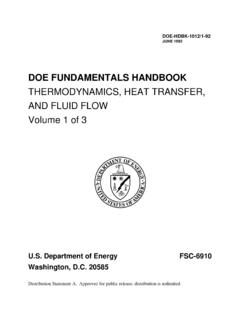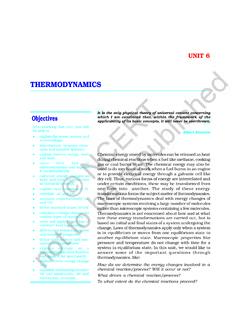Transcription of Chapter 20: Entropy and the Second Law of Thermodynamics
1 Chapter 20: Entropy and the Second Law of Thermodynamics The Conservation of Energy law allows energy to flow bi-directionally between its various forms. For example in a pendulum, energy continually goes to/from kinetic energy and potential energy. Entropy is different: No conservation law the Entropy change S associated with an irreversible process in a closed system is always greater than or equal to zero. Ice in water 1. only from ice into water 2. only from water into ice 3. both ways Consider putting some ice into a glass of water. Conservation of energy would allow energy to flow: Entropy and the Second Law of Thermodynamics That direction is set by a quantity called Entropy Only one of these scenarios happens, so something must be controlling the direction of energy flow. Consider putting some ice into a glass of water. Conservation of energy would allow: ice getting colder and water getting hotter. ice getting warmer and water getting cooler.
2 Both ice and water staying at their initial temperatures. Entropy and the Second Law of Thermodynamics But what about the ice? The ice is a very ordered state with all of the molecules in specific locations in the crystal. (W small) Nature will maximize number of energetically-allowed microstates. Liquid water has many states for the water molecules. (W large) Thus, heat (energy) always flows from the water to the ice. Two equivalent ways to define the Entropy in a system: (1) In terms of the system s temperature and the energy change the system gains or loses as heat, or; (1) By counting the ways in which the components of the system can be arranged. (huh?) Definition of change in Entropy : Q: energy transferred as heat T: temperature in Kelvin sign of S and Q SI unit of S: J/K Entropy is a state It does not depend on the process, only depends on the initial and final states. Relationship between Entropy and heat What are some other state properties?
3 P, V, E, and Entropy and the Small View (statistical Thermodynamics ) Let s bring the numbers down to illustrate the relationship between Entropy and probability. Consider an insulated box containing six molecules (N=6). The box is divided into the left half and the right half. Let n1 be the number of molecules in the left half and n2 be the number of molecules in the right half. Note: N = n1 + n2 We now selectively pick molecules to be placed in the left half. 1st molecule we can pick any of the six available molecules. 2nd molecule we can pick any of the five remaining molecules. Total number of ways we can select the six molecules = 6! = 720 Entropy and Probability (Section 20-8) Six indistinguishable molecules can be selected to be located 720 (6 ! or six factorial ) different ways. There are 4! (=24) different ways we could have put four molecules in the left side and 2! (=2) different ways we could have out the other two molecules in the right half.
4 Multiplicity W is the resulting number of microstates. Note: 0! = 1 and 6! = 6 . 5 . 4 . 3 . 2 . 1 = 720 This W is NOT work: Many books use for multiplicity) Entropy Continuing with all possible combinations of the six molecules in the two halves: Label n1 n2 Multiplicity W I 6 0 6!/(6!.0!) = 1 II 5 1 6!/(5!.1!) = 6 III 4 2 6!/(4!.2!) = 15 IV 3 3 6!/(3!.3!) = 20 V 2 4 6!/(2!.4!) = 15 VI 1 5 6!/(1!.5!) = 6 VII 0 6 6!/(0!.6!) = 1 The most likely state (highest probability) is the state with the greatest multiplicity, WIV with three molecules in each half (most disordered). Entropy So, .. How does this play out in Thermodynamics ? Entropy is the Boltzmann constant (k = J/K) times the natural log of W. S = k ln W Chapter 20 Entropy and the Second Law of Thermodynamics Example with the ice and water Suppose kg ice at 0oC (273K) is in water at 20oC (293K). Calculate Heat transfers: Qmelt = miceLf = ( )( ) = Qwater = mwatercw T => T = Qwater/mwatercw = Qwater = mwatercw( Tf) = micewatercw(Tf 273) Tf = ( + 273micewater)/(micewater + mwater) = Chapter 20 Entropy and the Second Law of Thermodynamics What is the change in Entropy of the ice as it melts at 0oC?
5 Convert all temperatures into Kelvin!! Suppose kg ice at 0oC (273K) is in water at 20oC (293K). Example with the ice and water Chapter 20 Entropy and the Second Law of Thermodynamics What is the change in Entropy of the ice water as it warms up to the final temperature? Suppose kg ice at 0oC (273K) is in water at 20oC (293K). Example with the ice and water Chapter 20 Entropy and the Second Law of Thermodynamics What is the change in Entropy of the water as it melted the ice? Suppose kg ice at 0oC (273K) is in water at 20oC (293K). Example with the ice and water Chapter 20 Entropy and the Second Law of Thermodynamics What is the change in Entropy of the water as it cooled down to the final temperature? Suppose kg ice at 0oC (273K) is in water at 20oC (293K). Example with the ice and water Chapter 20 Entropy and the Second Law of Thermodynamics Total change in Entropy of the ice / water system as it came to thermal equilibrium Suppose kg ice at 0oC (273K) is in water at 20oC (293K).
6 Stotal = Smelt + Sicewater + Swatermelt + Swatercooled = (+ + + + ) J/K = + J/K Example with the ice and water Definition of change in Entropy : Q: energy transferred as heat T: temperature in Kelvin sign of S and Q SI unit of S: J/K Entropy is a state It does not depend on the process, only depends on the initial and final states. Relationship between Entropy and heat What are some other state properties? ..p, V, E, and Reversible and Irreversible Processes Note: ALL real processes are irreversible! If an irreversible process occurs in a closed system, the Entropy S of the system always increases, it never decreases. ( Entropy postulate) An irreversible process is one that cannot be reversed by means of small changes in the environment. Entropy increases. A broken egg can not go back to being a whole egg. Heat does not transfer from the ice to the water (though this would not violate the law of energy conservation).
7 S > 0 Sample Problem Water is heated on a stove. Which of the following temperature changes results in the greatest change in Entropy ? 1. from 10oC to 20oC 2. from 45oC to 55oC 3. from 80oC to 90oC 4. all have the same Entropy change Sample Problems => 283K to 293K => 318K to 328K => 353K to 363K => ln(293/283) = => ln(328/318) = => ln(363/353) = Water is heated on a stove. Which of the following temperature changes results in the greatest change in Entropy ? (1) from 10oC to 20oC (2) from 45oC to 55oC (3) from 80oC to 90oC (4) all have the same Entropy change. The Second Law of Thermodynamics For the free expansion, we have S > 0. It is an irreversible process in a closed system. For the reversible isothermal process, for the gas S > 0 for expansion and S < 0 for compression. However, the gas itself is not a closed system. It is only a closed system if we include both the gas and the reservoir. during expansion: So: Stotal = 0 If a process occurs in a closed system, the Entropy of the system increases for irreversible processes and remains constant for reversible processes.
8 It never decreases. ( Second Law of Thermodynamics ) Reversible and Irreversible Processes A reversible process is one that can be reversed by means of small changes in the environment. In this case, S = 0. An isothermal expansion/compression of an ideal gas. The Second Law says that not only can t you come out ahead -- you *can t* even break even!!?!! S = 0 reversible process; S > 0 irreversible process *Everything* you do will increase the Entropy of the universe! Second Law of Thermodynamics Calculate S for the reversible isothermal process. since T = constant: In isothermal expansion, Q > 0, therefore S > 0 that means S > 0 for free expansion For a process that T is small compared to T : Let pA = x 105 Pa, VB = VA, TH = 600 K, and TL = 300 K. p V A B C D Problem 2 PROBLEM 2: (25pts) One mole of an ideal, monatomic gas is the working substance of an ideal heat engine. The system is initially at point A with pressure (pA), volume (VA), and temperature (TA=TH).
9 It is then allowed to expand isothermally to point B, then cool isochorically to point C, then contract isothermally to point D, then finally warm-up isochorically back to the initial point A. A. What is the volume this gas occupies at point A? Let pA = x 105 Pa, VB = VA, TH = 600 K, and TL = 300 K. p V A Ideal gas Law pV = nRT Part A PROBLEM 2: (25pts) One mole of an ideal, monatomic gas is the working substance of an ideal heat engine. The system is initially at point A with pressure (pA), volume (VA), and temperature (TA=TH). B. What is the work done by the gas WAB in going from A to B? PROBLEM 2: (25pts) One mole of an ideal, monatomic gas is the working substance of an ideal heat engine. The system is initially at point A with pressure (pA), volume (VA), and temperature (TA=TH). It is then allowed to expand isothermally to point B p V A B How can it isothermally go from A to B? pV = nRT Both p and V *must* change such that their product (nRTH) is a constant.
10 TH B. What is the work done by the gas WAB in going from A to B? PROBLEM 2: (25pts) One mole of an ideal, monatomic gas is the working substance of an ideal heat engine. The system is initially at point A with pressure (pA), volume (VA), and temperature (TA=TH). It is then allowed to expand isothermally to point B But if V increases, the gas does positive work ( , energy leaves the gas). p V A B TH WAB pV = nRT => p = nRT/V B. What is the work done by the gas WAB in going from A to B? PROBLEM 2: (25pts) One mole of an ideal, monatomic gas is the working substance of an ideal heat engine. The system is initially at point A with pressure (pA), volume (VA), and temperature (TA=TH). It is then allowed to expand isothermally to point B Since the internal energy doesn t change, energy (heat) must be added to compensate for the work the gas does. p V A B TH QAB WAB Eint = Q W = 0 => QAB = WAB B*. What is the heat added to the gas QAB in going from A to B?
